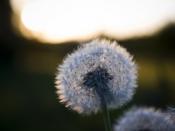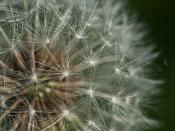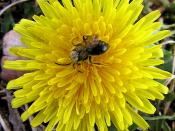A. Identity
The name dandelion is derived from the French dent de lion, meaning lion's tooth, describing its characteristic jagged-edged and bright-green leaves. The dandelion is a small rosette-forming perennial plant, regarded by most as a weed. Part of the family Compositae, the dandelion grows up to eighteen inches tall and has a hollow stalk filled with a whitish milk-like substance. The seeds of the dandelion form clocks, which are round balls with parachutes of hairs. Commonly known as a Blow Ball, Swine Snout, Piss-a-beds, Lion's Tooth, Priests Crown, Pu Gong Ying, and the King of Weeds, the dandelion belongs to the species Taraxacum officinale.
B. Location
The dandelion can be found in almost all of the fields, hedgerows, lawns and waste places of the word, even though it is a native of Europe. After its seeds were brought across the ocean by explorers, the dandelion spread at a rapid rate across North America.
After several centuries of growing in all areas inhabited by humans, most homeowners consider the dandelion as a pest and a weed.
C. Properties
The first medicinal use of the dandelion was recorded in Europe during 1485. The juice in the stalk of this supposed weed has natural antibacterial properties and contains PABA (Para amino benzoic acid, dietary supplement) that is otherwise found being sold in capsules or extracts. The dandelion also contains fats, iron, magnesium, niacin, phosphorous, zinc, and other various proteins. The plants itself contains a natural source and abundance of potassium and its leaves and flowers are rich in vitamins B1, B2, B5, B6, B9, B12, C, E, G, P. The leaves are the main source of vitamin A, with 7,000 units per oz (six times more units than in the same amount of lettuce). The dandelion, which is a...


